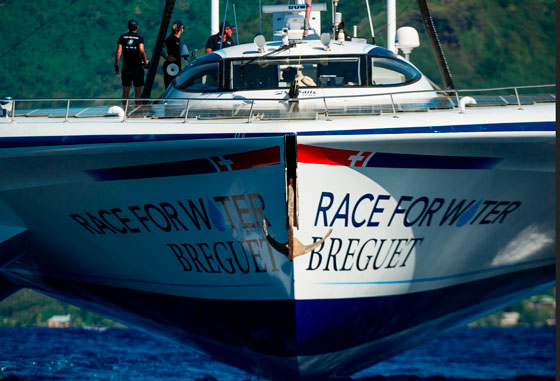
Breguet joined Race for Water in March 2018 as the main sponsor of a five-year program, entitled “Odyssey 2017-2021” with a crucial mission for the oceans.
This collaboration started within a long-term strategy. Breguet committed to support the Race for Water pioneering vessel sailing the seas around the world and to contribute to raising awareness among decision-makers and general public, as well as educating the young generations.
Throughout 2018, the Race for Water vessel, powered by a mix of solar, hydrogen, and kite energies, has travelled with stopovers in several islands and coastal cities demonstrating that clean energy transition is a reality. Having left Panama in March 2018, the boat continued to Peru and Chile, and sailed in the Pacific Ocean with stopovers in the Robinson Crusoe Island, Rapa Nui (formerly known as the Easter Island), French Polynesia, to arrive to the Samoan Islands in November and Tonga Islands in December. Since the beginning of the Odyssey, the vessel visited 9 countries, welcomed aboard over 3,200 children and met over 8,500 official guests.
The Race for Water scientific research proved that “plastic islands” do not exist. Micro particles of plastic drift in the ocean; while only 1% of the plastic remains at the surface. The Foundation, created in 2010 by Swiss entrepreneur Marco Simeoni, is working towards offering solution for preserving the oceans from plastic pollution, a genuine environmental disaster on a planetary scale.
“The solution is on land”, explained Marco Simeoni, Founder and CEO of the Race for Water Foundation. “Combined action is essential in preventing plastic waste from reaching the waterways and the oceans through the development of sustainable social models and business models that inspire its collection. Together with Montres Breguet, we are aiming at getting closer to making our dream of a better world come true.”
Simeoni further commented: “We have come up with a technology capable of transforming end-of-life plastics into energy, either gas or electricity. The sale of this energy will allow the community to pay street collectors and encourage them to pick up end-of-life plastics. The solution implementation is a long process, and a minimum of two years passes between the first contact and putting the machine into operation on-site. I would be very pleased if in 2020 we saw our projects transform into a ‘proof of concept’, demonstrating that the technological solution is viable and applicable.”
January 17, 2019


 News
News